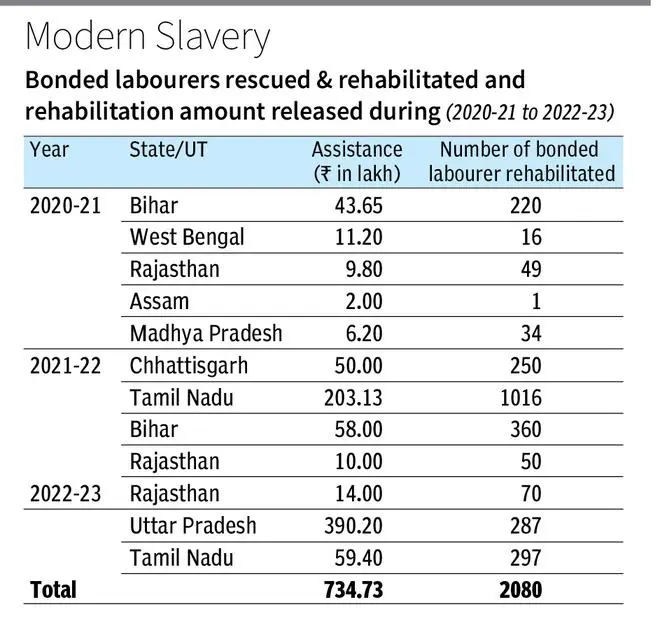
About 84 per cent of India’ bonded labourers identified and released to date come from five States - Karnataka, Tamil Nadu, Odisha, Uttar Pradesh and Andhra Pradesh. A total of 3,15,302 bonded labourers have been released till date, and from 1978 to January 31, 2023, a total 2,96,305 bonded labourers have been rehabilitated. In 2016, the Central government declared its intention to release and rehabilitate 1.84 crore bonded labourers across the country.

The 41st report of the Lok Sabha’s Standing Committee on labour, textiles, and skill development (2022-23), reveals that despite regular advisories from the Ministry of Labour and Employment to State/UTs, urging them to identify districts suitable for surveys and related initiatives aimed at the welfare of bonded labourers, there is a lack of tangible or substantial progress in the efforts to eliminate bonded labour.
“The committee, therefore, impress upon the Ministry to reinforce their coordinating and monitoring mechanism so as to ensure eradication of this social evil. The committee desires that the Ministry intensify the efforts towards establishing the National Portal on Bonded Labour so that the welfare measures prescribed for bonded labour are well disseminated, and benefits are truly and accurately extended to them” the report added.

Article 23 of the Constitution of India- Prohibition of Traffic in Human Beings and Forced Labour provides that traffic in human beings and beggar and other similar forms of forced labour are prohibited, and any contravention of this provision shall be an offence punishable by the law.
The National Human Rights Commission of India defines bonded labour as a form of slavery known as debt bondage, which has persisted for centuries. Regarded as the most egregious form of modern slavery, it operates as a lucrative enterprise where labourers are compelled to toil for extended periods while receiving minimal compensation. This includes instances where individuals are coerced to work for a specified duration by an employer without remuneration, often as a method of settling a debt.
The status of a bonded labourer arises when their labour is requisitioned as a means of repaying a loan. While not all bonded labour is explicitly forced, the majority of forced labour practices, whether involving children or adults, exhibit characteristics associated with bonded labour.
The research study titled ‘Assessing Budgetary Priorities for the Rehabilitation of Bonded Labour,’ authored by Jawed Alam Khan and published by the Centre for Budget and Governance Accountability in 2018, underscores that the prevalence of bonded labour is a significant issue within the informal sector of the Indian economy.
Initially concentrated in agriculture and allied sectors, bonded labour has now extended its reach into various non-agricultural domains, reflecting shifts in industries and occupations over time.
The study focusses on bonded labour in seven States: Bihar, Uttar Pradesh, Rajasthan, Madhya Pradesh, Telangana, Karnataka, and Tamil Nadu. According to the study, individuals trapped in bonded labour encounter various challenges, including prolonged working hours, coercion, irregular or absent wages, indebtedness due to loans or social obligations, and limitations on mobility between employers. The study highlights that approximately 10 per cent of India’s workforce falls under the classification of bonded labour.
Furthermore, the research indicates that 83 per cent of the total rehabilitated bonded labourers belong to Scheduled Castes (SCs) or Scheduled Tribes (STs). Women and children constitute a large chunk of bonded labourers.
Published on December 8, 2023

Comments
Comments have to be in English, and in full sentences. They cannot be abusive or personal. Please abide by our community guidelines for posting your comments.
We have migrated to a new commenting platform. If you are already a registered user of TheHindu Businessline and logged in, you may continue to engage with our articles. If you do not have an account please register and login to post comments. Users can access their older comments by logging into their accounts on Vuukle.